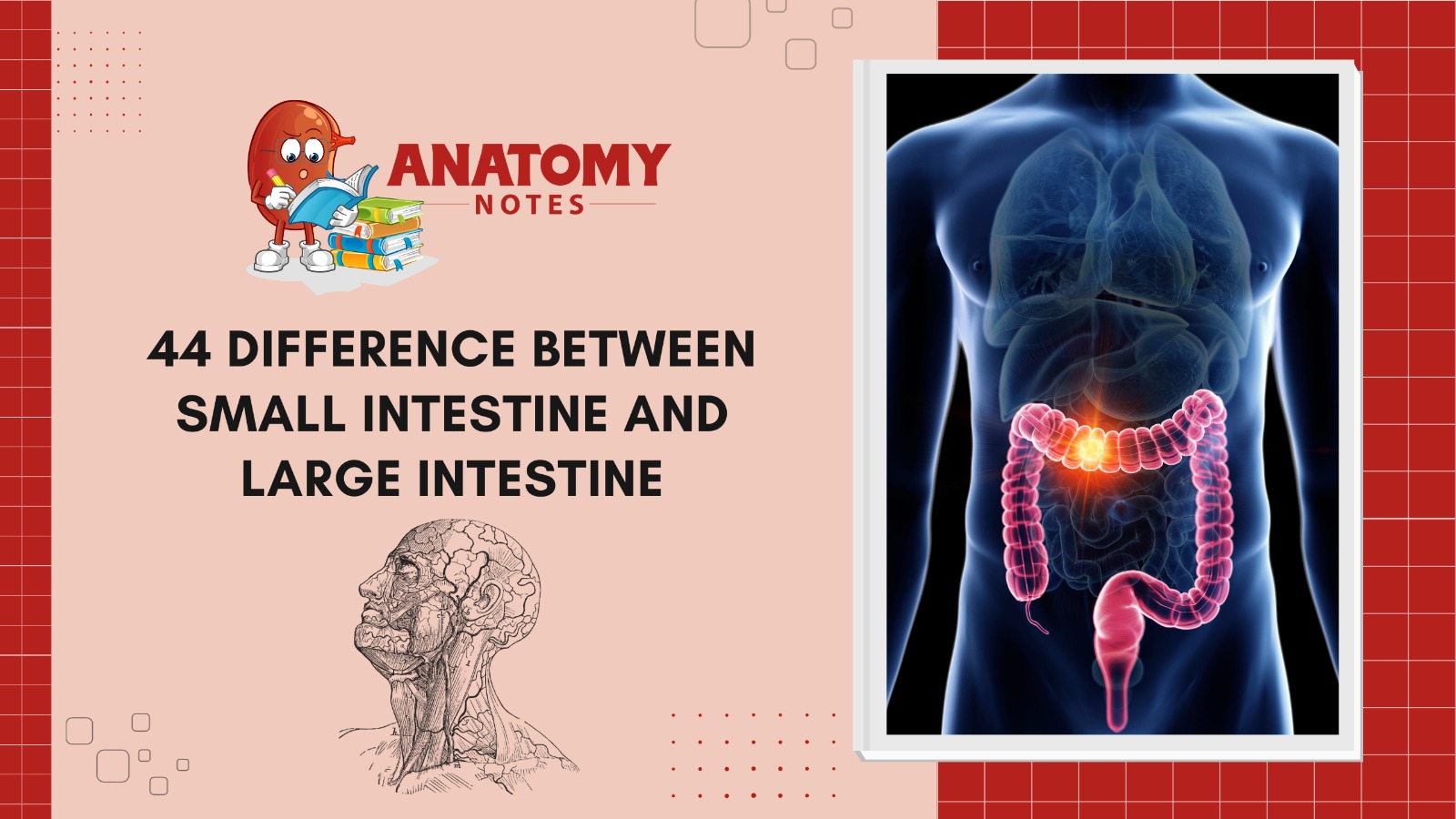The human digestive system relies on the small and large intestines to break down food and absorb nutrients. Though named differently, their distinctions go beyond size. To efficiently extract nutrients and eliminate trash, these distinctions are crucial.
The small intestine is longer and thinner than the large intestine and has three segments: duodenum, jejunum, and ileum. This complex organ absorbs most nutrients. Microvilli cover tiny finger-like villi on the small intestine walls. The intestine’s surface area increases, making it easier to absorb nutrients including carbs, proteins, lipids, and vitamins. The liver and pancreas provide bile and digestive enzymes to the small intestine, which breaks down food.
The colon is shorter and broader than the big intestine. The main role is to absorb water and electrolytes from undigested food to generate feces for disposal. The big intestine has a smoother lining and no villi. Beneficial gut microbiota microorganisms distinguish the large intestine. These bacteria produce gases and vitamin K and B vitamins by fermenting undigested carbohydrates.
Material movement via each organ differs. Peristalsis moves food and digestive fluids through the small intestine, ensuring effective mixing and nutritional absorption. However, the large intestine moves slowly and deliberately to compress feces and reabsorb water.
While both the small and large intestines are essential to digestion and health, they serve different functions. Due to its enormous surface area and villi-covered lining, the small intestine absorbs nutrients well, whereas the large intestine’s bacteria absorb water and generate feces. These distinctions help us understand these organs’ complicated relationship and how they affect digestion.
Also Read: An Overview of the Lymphatic System’s Function & Organs
Here are 44 differences between the small intestine and the large intestine:
|
S.No. |
Aspects |
Small Intestine |
Large Intestine |
|
1 |
Location |
Located between the stomach and the large intestine |
Located after the small intestine and before the rectum |
|
2 |
Length |
Longer in length (about 20 feet or 6 meters) |
Shorter in length (about 5 feet or 1.5 meters) |
|
3 |
Diameter |
Smaller in diameter than the large intestine |
Larger in diameter than the small intestine |
|
4 |
Subdivisions |
Divided into three parts: duodenum, jejunum, and ileum |
Divided into cecum, colon, and rectum |
|
5 |
Digestive Function |
Main site of nutrient absorption, including carbohydrates, proteins, and fats |
Absorbs water and electrolytes, and stores waste |
|
6 |
Villi and Microvilli |
Contains villi and microvilli to increase surface area for absorption |
Lacks villi and microvilli |
|
7 |
Mucosal Surface Area |
Has a larger mucosal surface area for absorption |
Has a smaller mucosal surface area |
|
8 |
Muscular Layer |
Has a thicker muscular layer for mixing and propelling contents |
Has a thinner muscular layer |
|
9 |
Absorption Sites |
Absorbs nutrients, vitamins, and minerals, including iron and calcium |
Absorbs water, electrolytes, and some vitamins |
|
10 |
Transit Time |
Faster transit time (around 4-6 hours) |
Slower transit time (around 12-48 hours) |
|
11 |
Bile and Pancreatic Enzymes |
Receives bile and pancreatic enzymes for digestion |
Receives minimal bile and enzymes |
|
12 |
Feces Formation |
Feces are not present, as it’s primarily an absorption site |
Feces formation begins in the cecum |
|
13 |
Fecal Composition |
Feces contain water, electrolytes, and undigested food residues |
Feces primarily consist of indigestible materials |
|
14 |
Role in Water Absorption |
Limited role in water absorption |
Main site for water absorption |
|
15 |
Gut Flora |
Contains relatively fewer gut bacteria |
Contains a large population of gut bacteria |
|
16 |
Role in Vitamin Synthesis |
Does not synthesize significant vitamins |
Synthesizes certain vitamins (e.g., vitamin K, some B vitamins) |
|
17 |
Role in Immune System |
Contains isolated lymphoid nodules (Peyer’s patches) |
Contains more significant lymphoid tissue |
|
18 |
Storage of Fecal Material |
Does not store fecal material |
Stores fecal material before elimination |
|
19 |
Absorption of Bile Salts |
Absorbs and recycles bile salts |
Does not absorb bile salts |
|
20 |
Stomach Connection |
Connected directly to the stomach via the pyloric sphincter |
Connected to the stomach via the ileocecal valve |
|
21 |
Role in Gas Production |
Limited role in gas production |
Significant gas production by gut bacteria |
|
22 |
Hormone Secretion |
Secretes hormones like secretin and cholecystokinin |
Secretes hormones like gastrin and motilin |
|
23 |
Role in Formation of Fecal Mass |
Does not contribute to the formation of fecal mass |
Begins the process of forming fecal mass |
|
24 |
Main Function |
Primary function is absorption and digestion of nutrients |
Primary function is absorption of water and electrolytes |
|
25 |
Blood Supply |
Receives blood supply from the superior mesenteric artery |
Receives blood supply from the superior mesenteric artery and inferior mesenteric artery |
|
26 |
Storage of Fecal Material |
Does not store fecal material |
Stores fecal material before elimination |
|
27 |
Goblet Cells |
Contains goblet cells that produce mucus for lubrication |
Contains goblet cells, which produce mucus for protection and lubrication |
|
28 |
Main Absorption Site for Nutrients |
Primary site for absorption of nutrients and minerals |
Absorbs water and some nutrients |
|
29 |
Role in Stool Formation |
Does not contribute to stool formation |
Begins the process of stool formation |
|
30 |
Role in Stool Consistency |
Does not significantly influence stool consistency |
Can influence stool consistency |
|
31 |
Role in Absorption of Electrolytes |
Limited role in electrolyte absorption |
Main site for electrolyte absorption |
|
32 |
Main Digestive Enzymes |
Receives digestive enzymes from the pancreas and liver |
Does not receive digestive enzymes |
|
33 |
Gastrointestinal Diseases |
Less susceptible to gastrointestinal diseases |
Can be prone to conditions like diverticulitis, colitis, and irritable bowel syndrome |
|
34 |
Motility |
Exhibits faster peristaltic contractions |
Exhibits slower peristaltic contractions |
|
35 |
Secretion of Mucus |
Produces mucus primarily for lubrication |
Produces mucus for protection and lubrication |
|
36 |
Role in Digestive Enzyme Production |
Does not produce digestive enzymes |
Does not produce digestive enzymes |
|
37 |
Role in Stool Formation |
Does not significantly contribute to stool formation |
Begins the process of stool formation |
|
38 |
Role in Absorption of Electrolytes |
Limited role in electrolyte absorption |
Main site for electrolyte absorption |
|
39 |
Main Digestive Enzymes |
Receives digestive enzymes from the pancreas and liver |
Does not receive digestive enzymes |
|
40 |
Gastrointestinal Diseases |
Less susceptible to gastrointestinal diseases |
Can be prone to conditions like diverticulitis, colitis, and irritable bowel syndrome |
|
41 |
Motility |
Exhibits faster peristaltic contractions |
Exhibits slower peristaltic contractions |
|
42 |
Secretion of Mucus |
Produces mucus primarily for lubrication |
Produces mucus for protection and lubrication |
|
43 |
Role in Digestive Enzyme Production |
Does not produce digestive enzymes |
Does not produce digestive enzymes |
|
44 |
Role in Hormone Production |
Secretes hormones related to digestion (e.g., secretin) |
Secretes hormones related to digestion and motility (e.g., gastrin) |
Also Read: Gastrointestinal System – Intro, Functions, Movements & Organs Associated
Frequently Asked Questions (FAQS)
- What are the small and big intestines’ principal functions?
The small intestine absorbs most nutrients from digested food. Villi and microvilli improve the surface area for effective absorption of carbs, proteins, lipids, and vitamins. In contrast, the large intestine absorbs water and electrolytes and forms and compacts feces. It contains intestinal bacteria that ferment and create vitamins.
- How do the structures of the small intestine and large intestine differ?
The small intestine’s villi and microvilli maximize nutrition absorption surface area. Large intestines have smoother inner linings and lack these features. The small intestine’s considerable folding and three segments (duodenum, jejunum, and ileum) help it absorb nutrients, whereas the large intestine’s broad width helps it absorb water.
- What do enzymes and bacteria perform in these organs?
The pancreas supplies digesting enzymes and the liver bile to the small intestine. These enzymes convert food into absorbable molecules. The microbiota of the large intestine is varied. These bacteria ferment undigested carbs, generating gases and vitamins K and B.
- Do the small and big intestines transport material differently?
Peristalsis moves food and digestive fluids through the small intestine. This movement mixes and absorbs nutrients efficiently. In contrast, the large intestine moves slowly and deliberately to compress feces and absorb water. This slow movement is essential for well-structured feces.
- Do the small and big intestines act separately?
No, these organs work together to digest and use nutrients. The small intestine breaks down stomach-digested food for nutrients. The bloodstream transports ingested nutrients throughout the body. The large intestine reclaims water and microorganisms finish the feces with the undigested material. Both organs work together to support the body’s nutritional demands and waste disposal.




